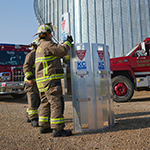Don't work alone - grain bin dangers
Grain engulfment or suffocation can happen in seconds. Create a labor resource plan to help ensure trained professionals are ready when needed.
Avoid working alone in grain bins
Entering a grain bin is a minimum two-person job. The person entering the bin and a reliable attendant outside the space whose one and only job is to watch the person in the bin. If the person in the bin becomes unresponsive or trapped, the attendant should not enter the bin, but call for emergency services.
It’s hard to resist the urge to work alone when the job is urgent and no one is around to help you. But nothing is worth compromising safety, even if it means postponing that job until someone else is present. Cutting corners may save time — but doing so puts you and others at grave risk.
That’s why we recommend that farmers make a three-word commitment to themselves, their families and friends — don’t work alone. This pledge requires planning and discipline, but consistent adherence can help prevent severe injury and death.
Farm operations require significant planning, from financial and marketing to agronomic and daily job duties. Developing a labor resource plan to help ensure no one works alone should be equally important. It plays a critical role in helping create a safe work environment and can help provide farmers with resources for assistance.
Five steps to grain bin safety planning
Step 1: Lay the foundation for your plan with expertise and equipment
Start by doing your homework. The Occupational Safety and Health Administration’s (OSHA) grain handling standards and safe-work procedures for grain bin entry provide a lot of helpful ideas on how to work safely in and around grain bins. The guidelines are specifically for commercial grain handling facilities. But they can also help grain farmers begin to develop a plan that helps maintain the highest safety standards when working around grain bins.
There are a lot of new products and tools available to help you work more safely around grain bins. Determine which products like electronic monitoring and control systems or products that break up grain clumps will be most helpful to you in avoiding working alone in and around your bins. See some of the latest products to help you work safely.
Step 2: Add grain bin safety to existing farm plans
Farmers are no strangers to planning. Day-to-day work, financial management, agronomy and marketing are all parts of successfully operating a farm. And they all require planning. Add your plan for working safely in and around your grain bins — specifically never working alone — to the other plans you create and follow every day on the farm.
Step 3: Consider your labor resources
Once you’ve committed to prioritizing grain bin safety and have done your homework to learn about necessary safety tools protocols, it’s time to develop a labor resource plan. Your plan should start with a list of anyone who can help with grain handling work. That includes family members, friends and current or potential farm employees.
Once you know your labor resources, communicate your expectations for prioritizing safety whenever working in or around grain bins, specifically the steps necessary to ensuring no one ever works in a bin alone. That may mean posting written notice of your safety priorities or it may mean simply discussing how to work safely with others in your labor pool.
Step 4: Get and keep everyone on the same page
Whatever role you request of others working on your farm when working in or around grain bins, make sure everyone is on the same page. That starts with the right grain safety training, then instructing on the procedures you follow and the equipment you use for ensuring no one works alone in or around grain bins.
Worker training can be provided on-site or with the assistance of local experts like cooperative managers, university extension specialists and local ag organizations.
Once you’ve got everyone on the same page with instruction and education, keep them there. Communicate your safety expectations and priorities regularly with all workers. Doing so not only makes it easier to keep everyone informed of necessary safety precautions, but also will enable workers to react more quickly and efficiently in the event of a grain bin safety emergency.
Step 5: Get and keep everyone on the same page
Knowledge grows with experience. That’s especially true with grain bin safety. Even if you created your grain bin safety plan, review it — along with your farm’s labor resource plan — regularly and be prepared to update it if needed.
This way, you’re using your growing experience to be even better prepared to not only work safely in and around grain bins, but also respond to an emergency if it happens. Taking the time to do this will also help reaffirm all workers’ commitment to never work alone.
The benefits of planning
Committing to never working alone is a huge step toward a safer operation. Building and maintaining a labor resource plan that includes grain safety training for all workers can also help you maintain a safe, productive working environment. Get more tips on grain bin safety and accident prevention through MyNSightOnline’s Grain Bin Safety resources.
Lean more about Nationwide agribusiness insurance. Find a farm agent.

 >
>

 >
>
 >
>